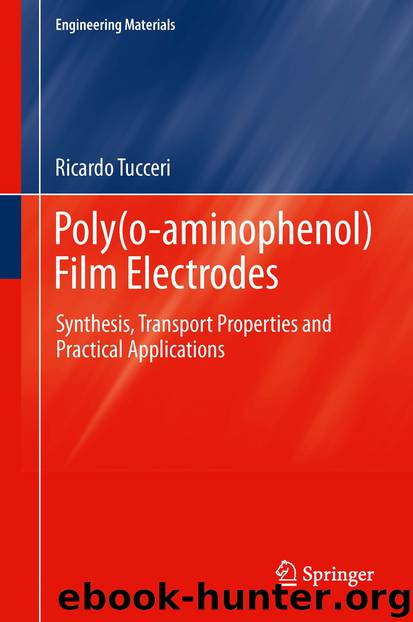Poly(o-aminophenol) Film Electrodes by Ricardo Tucceri

Author:Ricardo Tucceri
Language: eng
Format: epub
Publisher: Springer International Publishing, Cham
2.2.3 Effects of the Type and Concentration of Ions of the External Solution on the Charge-Transport Process at POAP Films
Effects of the type and concentration of ions of the supporting electrolyte on the electrochemical response of POAP films were studied in several papers [1, 11, 18, 31, 42]. Some voltammetric experiments were performed in Ref. [1] by varying the ClO4 − concentration between 0.1 and 1.7 M. While the anodic peak was not affected, the cathodic peak showed a positive variation. In this sense, a high concentration of perchlorate produces the same effect as a high proton concentration, making POAP more easily reducible. However, no noticeable changes were observed for anions such as SO4 2−, PO4 3− and Cl− or cations such as Li+, K+ and Cs+.
The participation of the supporting electrolyte anions in charge-transfer processes through POAP films was studied in LiClO4 and HClO4 solutions at different pH values and constant ionic strength (1 M) by employing CV and EQCM [11]. CV experiments with POAP-modified electrodes uncovered and covered with Nafion thin films were performed [11]. Nafion is known to hinder anionic permeability due to its own negative charge, so the films covered with this material should significantly change their electrical properties, as compared to the uncovered ones, when supporting electrolyte anions participate in the redox activity of the films. No significant effect of Nafion on the redox response of POAP was observed. This finding allowed the authors [11] to conclude that no perchlorate anions are involved in the redox reactions of POAP. In order to confirm this conclusion, EQCM measurements on POAP films were carried out in Ref. [11]. The microbalance frequency change in the presence of the POAP films was measured simultaneously with their current responses under the electrode potential cycling. The ratio, where (k is the constant of the Sauerbrey law) and is the charge consumed during the oxidation/reduction process, gave a mass number of about 3–5 in the main range of the cycling potential of 0.0–0.3 V (vs. Ag/AgCl). This mass number was considered very low, as compared with the molecular weight of ClO4 − anion. Then, it was concluded that an insignificant insertion of the anions into the POAP films occurs during the redox reaction of the polymer.
The ionic exchange of POAP in the presence of perchlorate anions was studied by using Probe Bean Deflection (PBD) [31]. During the reduction scan only a positive deflection of the PBD signal was observed, which was indicative of a simultaneous expulsion of perchlorate and insertion of protons, the latter process being dominant. To check this conclusion, a PBD profile was simulated by convolution of the current response using parameters reported in the literature [43] and considering that only protons are exchanged between the solution and POAP. The simulated profile fits reasonably well the negative scan but differs significantly in the positive direction, suggesting that not only protons but also perchlorate anions are exchanged during the positive scan.
The effect of the ionic strength of the solution on the transport properties of POAP was studied employing EIE [18].
Download
This site does not store any files on its server. We only index and link to content provided by other sites. Please contact the content providers to delete copyright contents if any and email us, we'll remove relevant links or contents immediately.
| Automotive | Engineering |
| Transportation |
Whiskies Galore by Ian Buxton(41540)
Introduction to Aircraft Design (Cambridge Aerospace Series) by John P. Fielding(32893)
Small Unmanned Fixed-wing Aircraft Design by Andrew J. Keane Andras Sobester James P. Scanlan & András Sóbester & James P. Scanlan(32580)
Craft Beer for the Homebrewer by Michael Agnew(17938)
Turbulence by E. J. Noyes(7717)
The Complete Stick Figure Physics Tutorials by Allen Sarah(7148)
Kaplan MCAT General Chemistry Review by Kaplan(6605)
The Thirst by Nesbo Jo(6448)
Bad Blood by John Carreyrou(6286)
Modelling of Convective Heat and Mass Transfer in Rotating Flows by Igor V. Shevchuk(6231)
Learning SQL by Alan Beaulieu(6043)
Weapons of Math Destruction by Cathy O'Neil(5848)
Man-made Catastrophes and Risk Information Concealment by Dmitry Chernov & Didier Sornette(5672)
Digital Minimalism by Cal Newport;(5397)
Life 3.0: Being Human in the Age of Artificial Intelligence by Tegmark Max(5198)
iGen by Jean M. Twenge(5167)
Secrets of Antigravity Propulsion: Tesla, UFOs, and Classified Aerospace Technology by Ph.D. Paul A. Laviolette(5002)
Design of Trajectory Optimization Approach for Space Maneuver Vehicle Skip Entry Problems by Runqi Chai & Al Savvaris & Antonios Tsourdos & Senchun Chai(4849)
Electronic Devices & Circuits by Jacob Millman & Christos C. Halkias(4756)
